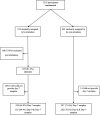A Randomized Controlled Trial to Study the Transmission of SARS-CoV-2 and Other Respiratory Viruses During Indoor Clubbing Events (ANRS0066s ITOC Study)
- PMID: 37795682
- PMCID: PMC10724450
- DOI: 10.1093/cid/ciad603
A Randomized Controlled Trial to Study the Transmission of SARS-CoV-2 and Other Respiratory Viruses During Indoor Clubbing Events (ANRS0066s ITOC Study)
Abstract
Background: In the context of the circulation of the severe acute respiratory syndrome coronavirus 2 (SARS-CoV-2) B.1.617.2 (Delta) variant, vaccination re-authorized mass indoor gatherings. The "Indoor Transmission of coronavirus disease 2019 (COVID-19)" (ITOC) trial (ClinicalTrials.gov, NCT05311865) aimed to assess the risk of transmission of SARS-CoV-2 and other respiratory viruses during an indoor clubbing event among participants fully vaccinated against COVID-19.
Methods: ITOC, a randomized controlled trial in the Paris region (France), enrolled healthy volunteers aged 18-49 years, fully vaccinated against COVID-19, with no comorbidities or symptoms, randomized 1:1 to be interventional group "attendees" or control "non-attendees." The intervention was a 7-hour indoor event in a nightclub at full capacity, with no masking, prior SARS-CoV-2 test result, or social distancing required. The primary outcome measure was the number of reverse transcriptase-polymerase chain reaction (RT-PCR)-determined SARS-CoV-2-positive subjects using self-collected saliva 7 days post-gathering in the per-protocol population. Secondary endpoints focused on 20 other respiratory viruses.
Results: Healthy participants (n = 1216) randomized 2:1 by blocks up to 10 815 attendees and 401 non-attendees, yielding 529 and 287 subjects, respectively, with day-7 saliva samples. One day-7 sample from each group was positive. Looking at all respiratory viruses together, the clubbing event was associated with an increased risk of infection of 1.59 (95% CI, 1.04-2.61).
Conclusions: In the context of low Delta variant of concern circulation, no evidence of SARS-CoV-2 transmission among asymptomatic and vaccinated participants was found, but the risk of other respiratory virus transmission was higher. Clinical Trials Registration. ClinicalTrials.gov, NCT05311865.
Keywords: COVID-19; indoor transmission; respiratory viruses; vaccination.
© The Author(s) 2023. Published by Oxford University Press on behalf of Infectious Diseases Society of America.
Conflict of interest statement
Potential conflicts of interest. L. B. L. N. reports consulting fees from Pfizer, Cemka, and AstraZeneca (outside the submitted work); payment or honoraria for lectures from Sanofi; conference travel support from Pfizer and Sanofi; an unpaid position on Board of 1001 Mots; and stock in Explain (unrelated to healthcare). C. D. reports payment or honoraria for speaking engagements from ViiV, MSD, and Gilead, as well as travel support from Gilead. P. C. reports grants or contracts with Agence Nationale de Recherche (ANR), ANRS-MIE, and ARS Bretagne; personal consulting fees from Sanofi, IQVIA, and Pfizer; travel support from Sanofi; and participation on a Data Safety Monitoring or Advisory Board for IQVIA. J. L. G. reports institutional funding for clinical research study (SALICOV-APHP) from the French Ministry of Health and the Assistance Publique-Hopitaux de Paris Foundation; and payment or honoraria for speaking engagements from Qiagen France SAS, MSD France, and Abbott Rapid Diagnostics SAS. All other authors report no potential conflicts. All authors have submitted the ICMJE Form for Disclosure of Potential Conflicts of Interest. Conflicts that the editors consider relevant to the content of the manuscript have been disclosed.
Comment in
-
SARS-CoV-2 Exposures at a Large Gathering Event and Acquisition of COVID-19 in the Post-Vaccination Era: A Randomized Trial Is Possible During the Pandemic.Clin Infect Dis. 2023 Dec 15;77(12):1656-1658. doi: 10.1093/cid/ciad609. Clin Infect Dis. 2023. PMID: 37797309 No abstract available.
References
Publication types
MeSH terms
Associated data
LinkOut - more resources
Full Text Sources
Medical
Miscellaneous


